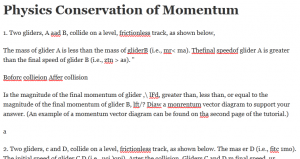Physics Conservation of Momentum

1. Two gliders, A aad B, collide on a level, frictionless track, as shown below,
The mass of glider A is less than the mass of gliderB (i.e., mr< ma). Thefinal speedof glider A is greater than the final speed of glider B (i.e., ztn > as). ”
Boforc collieion Affer collision
Is the magnitude of the final momentum of glider ,\ lFd, greater than, less than, or equal to the magnitude of the final momentum of glider B, lft/? Diaw a monrentum vector diagram to support your answer. (An example of a momentum vector diagram can be found on tha second page of the tutorial.)
a
2. Two gliders, c and D, collide on a level, frictionless track, as shown below. The mas er D (i.e., fitc 1mo). The initial speed of glider C D (i.e,, uci )opi). Arter the collision, Gliders C and D m final speed, ur.
Before collision After collision
Is the magnitude of the initial momentum of glider C_rlF./, greater than, less than, or equal to the magnitude of the initial momentum of glider D, lFD/? Draw a momentum vector diigram to support your answer.
Tutorials in Intoductory Physics McDermott, Shaffer, and the P.E,G., U. Wash.
‘ 2 @pearson Custom 2″0 nd., for U.CO, Boulder
Mech Conseroation of momentum in one dimension HW{0
3. Two astronauts, A and B, participate in three collision experiments in a weightless, frictionless environment. In each experimenl, astronaut B is initially at rest, and astronaut A has initial momentumi*= 20 kg-m/s to the right. (The velocities of the astronauts are measured with respect to a nearby space station.)
Before After
The astronauts push on each other in different ways so that the outcome of each experiment is different. As shown in the figure at right, astronaut A has a different final momentum in each experiment.
a. Determine the magnitude of the final momentum of astronaut B in each experiment. Explain.
b. Rank the three experiments according to the final kinetic energy of astronaut B, from largest to smallest. Explain.
c. Is the totalkinetic energy after the collision in experirfient2 greater than, less than, or equal to the total kinetiCenergy after the collision in experiment 3? (In this case, total kinetic energy means the sum of the kinetic energies of the two astronauts.) Explain.
d. Consider the following statement: “The momentum of the system is conserved in eoch experiment becouse there is no net f orce on the system. ff momentum is conserved, then kinetic ene?gY must olso be conserved, becouse both momentum ond kinetic energy ore mode up of moss ond velocity.”
One of the sentences above is completely correct. Discuss the error(s) in reasoning in the other sentence.
Tutorials in Introductory Physics McDermott, Shaffer, and the P.E.G., U. Wash.
@Peprson
Custom 2nd F1,., for U.CO, Boulder
Experirnents 1,2, and3
At rest
Consentation of momentum in one ditnenston Name
e. In the boxes below, draw the initial mompntum, the change in momentum, andthe final momentum for each astronaut in the three experiments. The initial momentum is shown for astronaut A. Draw the other vectors using the same scale.
Mech HW-61
Initial
If the net force on a system of two colliding objecls is zero, how does the change in momentum of one object compare to the change in momentum of the other object:
. in magnitude?
. in direction?
Bxplain how your answers to part f are consistent with Newton’s third law and the impulse- momentum theorem ( 4″t N = [F) for:
. each astronaut considered separately, and
. for the system of both astronauts together.
‘,
Tutorials in Introductory Physics McDermott, Shaffer, and the P.E.G., U. Wash.
@Pearson
Custom 2nd. Ed., for U.CO, Boulder
Mech Conseroation of momentum in one dimension HW-62
4. A pyrotechnician releases a 3-kg firecracker from rest. At t = 0.4 s, the firecracker is moving downward with speed 4 mls. At this same instant, the firecracker begins to explode into two pieces, “top” and “bottom,” with masses nt op 1 kg and ffibotto – 2kg. At the end of the explosion (/ = 0.6 s), the top piece is moving upward with speed 6 m/s.
The mass of the explosive substance is negligible in comparison to the mass of the two pieces.
The questions below can serve as a guide to completing the diagram below right:
a. Determine the magnitude of the net force on the firecracker system before the explosion. (Use I = 10 m/s’.) ExPlain.
b. Determine’the magnitude of the net force on the firecracker system at an instant during the explosion. (Hint: Does the net force on a system depend on forces that are internal to that system?)
Determine the magnitude and direction of the net impulse (\”rN) on the firecracker system during the explosion (i.e., over the interval from t =0.4 s until r = 0.6 s). Explain.
Use the impulse-momentum theorem to determine the magnitude and direction of the change in momentum of the firecracker system during the explosion. Enter this vector in the table using the scale set by the initial momentum of the system.
Determine the final momentum of the firecracker system and enter it in the table. (Hint: Is it the same as the initial momentum?)